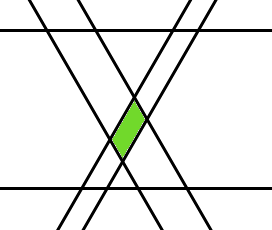Make one of these, maybe?

(Didn't see any requirements forbidding different sizes or overlapping.)
Here's another configuration:

Each corner of the coloured area is the tip for two triangles, one pointing up, the other pointing down. (I deliberately made the shape a bit irregular: as long as the angles are correct, every triangle will be equilateral.)
This shape isn't as nice as the first one though: there's going to be a lot of useless stick ends jutting out, just waiting to poke someone's eye out. The first shape can always be constructed so that every part of every stick is needed to form the triangles.
A third answer can be found between these two: move the top horizontal stick in the second shape down, so that it separates the top corner of the coloured area from the others. This flips one of the triangles, making the top part look like that in the first shape, but otherwise, everything stays the same.
Like so:

Edit: General solution
Now that I had some time to think about it, these are all (more or less) the same solution. As long as there's two sticks in all the three orientations corresponding to the sides of an equilateral triangle, and every stick crosses (or touches) all the non-parallel ones (with all the crossings and touchings happening at separate points), there will always be exactly 8 equilateral triangles: the oblique lines will always have exactly 4 crossing points, and each horizontal line will complete a triangle out of each crossing: it doesn't actually matter whether the horizontal line is above or below the crossing point. Here are a couple of examples not covered by the three cases above:


Because it would be wasteful to put any sticks at any other angles than those that make equilateral triangles with the unmoved sticks, there are only two other orientation distributions to check: 1-1-4 (max. 4 triangles can be made) and 2-1-3 that has a maximum of 6 triangles. This means that this approach covers all possible solutions. (std. disclaimer: unless I'm missing something.)






